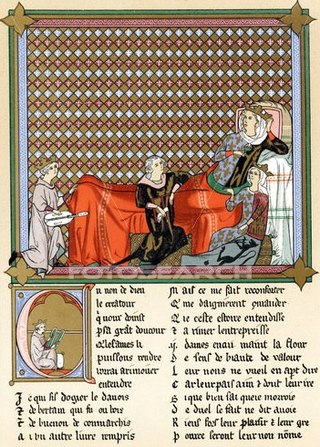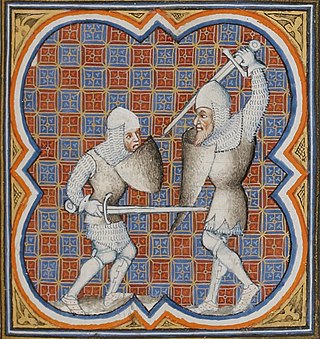Related Research Articles
Huon of Bordeaux is the title character of a 13th-century French epic poem with romance elements.

The chanson de geste is a medieval narrative, a type of epic poem that appears at the dawn of French literature. The earliest known poems of this genre date from the late 11th and early 12th centuries, shortly before the emergence of the lyric poetry of the troubadours and trouvères, and the earliest verse romances. They reached their highest point of acceptance in the period 1150–1250.
Doon de Mayence also known as Doolin de Maience, Doon de Maience or Doolin de Mayence was a fictional hero of the Old French chansons de geste, who gives his name to the third cycle of the Charlemagne romances dealing with the feudal revolts.

Ogier the Dane is a legendary paladin of Charlemagne who appears in many Old French chansons de geste. In particular, he features as the protagonist in La Chevalerie Ogier, which belongs to the Geste de Doon de Mayence. The first part of this epic, the enfance[s] of Ogier, is marked by his duel against a Saracen from whom he obtains the sword Cortain, followed by victory over another Saracen opponent from whom he wins the horse Broiefort. In subsequent parts, Ogier turns into a rebel with cause, seeking refuge with the King of Lombardy and warring with Charlemagne for many years, until he is eventually reconciled when a dire need for him emerges after another Saracen incursion.

Adenes le Roi, was a French minstrel or trouvère. He was a favourite of Henry III, duke of Brabant, and he remained at court for some time after the death of his patron in 1261.

Medieval French literature is, for the purpose of this article, Medieval literature written in Oïl languages during the period from the eleventh century to the end of the fifteenth century.

Oliver, sometimes referred to as Olivier de Vienne or de Gennes, is a legendary knight in the Matter of France chansons de geste, especially the French epic The Song of Roland. In the tradition, he was Roland's closest friend, advisor, confidant and brother-in-law to be, one of Charlemagne's twelve peers and brother of Aude, Roland's betrothed. He dies with Roland at the Battle of Roncevaux Pass. Some critics have linked his name to the olive tree, a biblical symbol of divine wisdom.
La Geste de Garin de Monglane is the second cycle of the three great cycles of chansons de geste created in the early days of the genre. It centres on Garin de Monglane. One of its main characters is William of Gellone.

Fierabras or Ferumbras is a fictional Saracen knight appearing in several chansons de geste and other material relating to the Matter of France. He is the son of Balan, king of Spain, and is frequently shown in conflict with Roland and the Twelve Peers, especially Oliver, whose prowess he almost rivals. Fierabras eventually converts to Christianity and fights for Charlemagne.

Ferragut was a character—a Saracen paladin, sometimes depicted as a giant—in texts dealing with the Matter of France, including the Historia Caroli Magni, and Italian epics, such as Orlando Innamorato by Matteo Maria Boiardo and Orlando Furioso by Ludovico Ariosto. In the tales, he was portrayed as physically invulnerable except at his navel/stomach, and was eventually killed by the paladin Roland.

The Historia Caroli Magni, also known as the Historia Karoli Magni et Rotholandi or the (Pseudo-)Turpin Chronicle, is a 12th-century Latin chronicle consisting of legendary material about Charlemagne's campaigns in Spain. The chronicle states it was written by Charlemagne's contemporary Turpin, Archbishop of Reims, but it was found out as a medieval forgery. The work was extremely popular, and served as a major source of material on Charlemagne in chronicles, fiction and iconography throughout Medieval Europe. The miracles of the flowering lances and the death of Ferracutus appear on the windows of Chartres cathedral.

Le Pèlerinage de Charlemagne is an Old French chanson de geste dealing with a fictional expedition by Charlemagne and his paladins. The oldest known written version was probably composed around 1140. Two 15th-century reworkings of the story are also known.

The Paladins, also called the Twelve Peers, are twelve legendary knights, the foremost members of Charlemagne's court in the 8th century. They first appear in the medieval chanson de geste cycle of the Matter of France, where they play a similar role to the Knights of the Round Table in Arthurian romance. In these romantic portrayals, the chivalric paladins represent Christianity against a Saracen (Muslim) invasion of Europe. The names of the paladins vary between sources, but there are always twelve of them led by Roland. The paladins' most influential appearance is in The Song of Roland, written between 1050 and 1115, which narrates the heroic death of Roland at the Battle of Roncevaux Pass.

The Karlamagnús saga, Karlamagnussaga or Karlamagnus-saga was a late-thirteenth-century Norse prose compilation and adaptation, made for Haakon V of Norway, of the Old French chansons de geste of the Matter of France dealing with Charlemagne and his paladins. In some cases, the Karlamagnús saga remains the only source for otherwise-lost Old French epics.

Galiens li Restorés, or Galien le Restoré or Galien rhétoré, is an Old French chanson de geste which borrows heavily from chivalric romance. Its composition dates anywhere from the end of the twelfth century to the middle of the fourteenth century. Five versions of the tale are extant, dating from the fifteenth century to the sixteenth century, one in verse and the others in prose. The story—which is closely linked to the earlier chansons de gestePèlerinage de Charlemagne and The Song of Roland —tells of the adventures of Galien, son of the hero Olivier and of Jacqueline, the daughter of the (fictional) emperor Hugon of Constantinople.
Jean Bagnyon or Jehan Bagnyon was a lawyer, historian, political writer, and translator born in 1412, in Croy, in the canton of Vaud, which was, at that time, a part of the Duchy of Savoy. He died sometime after 1487.

Entrée d'Espagne or L'Entrée d'Espagne or Entrée en Espagne is a 14th-century (c.1320) Franco-Venetian chanson de geste. The author is thought to be from Padua. The work has survived in only one manuscript, today in the Biblioteca Marciana in Venice. Based on material from the Pseudo-Turpin Chronicle and several other sources, the epic poem tells of Charlemagne's battles in Spain and the adventures of the paladin Roland.
Aiquin, subtitled La conqueste de la Bretaigne par le roy Charlemaigne, is a medieval Old French chanson de geste about the rivalry between a Saracen king, Aiquin, and the Christian emperor Charlemagne. The French medievalist Joseph Bédier called it a "consolidation of history and legend in an imposing ensemble." It survives in one fifteenth-century manuscript, BnF fr. 2233, now in the Bibliothèque nationale de France. It is usually attributed to Garin Trousseboeuf, possibly a cleric of Dol. According to historian Éric Borgnis-Desbordes, it was written in the early thirteenth century, probably around 1213 and under the guise of a chanson de geste featuring Charlemagne and the Viking invasions in the tenth century, the author may have alluded to “the transition from Plantagenet domination to Capetian influence in Brittany”. It is the oldest extant French text from Brittany.
Gaydon is a chanson de geste written in about 1230 AD. It recounts the story of Thierry, friend of Charlemagne in the Chanson de Roland, for whom "Gaydon" is another name. The text was first published in Paris in 1862 by François Guessard on the basis of three manuscripts in the Bibliothèque nationale de France ; of these, two date from the thirteenth century, and the third from the fifteenth.
Henri-Victor Michelant was a French librarian, romanist and medievalist.
References
- ↑ Mandach, Andre de (1987), "La geste de 'Fierabras' ou le jeu du réel et de l'invraisemblable", Au carrefour des routes d'Europe: La chanson de geste. Tome II, Presses universitaires de Provence, pp. 843–857, doi:10.4000/books.pup.2358, ISBN 978-2-901104-21-6
- ↑ NEWTH, MICHAEL A.H. (2010-03-01). Fierabras and Floripas. Italica Press, Inc. doi:10.2307/j.ctt1t88thm. ISBN 978-1-59910-158-3.
- ↑ Guessard, François (1814–1882). Luce, Siméon (1833–1892). (1966). Les anciens poètes de la France. chanson de geste publiée pour la première fois d'après les trois manuscrits de Paris. Kraus Reprint. OCLC 490913674.
{{cite book}}: CS1 maint: multiple names: authors list (link) - ↑ Foulet, Alfred (1967). "Jehan de Lanson: Chanson de geste of the 13th Century. John Vernon Myers". Speculum. 42 (3): 546. doi:10.2307/2851163. ISSN 0038-7134. JSTOR 2851163.
- ↑ Crifò, Francesco (2018-11-07). "Mattia Cavagna (ed.), Jean de Vignay: Le Miroir historial, vol. 1, tome 1 (livres I–IV) (Publications de la Société des Anciens Textes Français, 110), Paris, Société des Anciens Textes Français, 2017, 814 p.". Zeitschrift für Romanische Philologie. 134 (4): 1273–1274. doi:10.1515/zrp-2018-0089. ISSN 1865-9063. S2CID 165679757.
- ↑ Dougherty, David M.; Barnes, Eugene B., eds. (1981-01-01). "Le 'Galien' de Cheltenham". Purdue University Monographs in Romance Languages. 7. doi:10.1075/pumrl.7. ISBN 978-90-272-1717-2. ISSN 0165-8743.
- ↑ Houdeville, Michelle (1993), "La fin d'un monde: Une vision épique, la destruction de Gardayne, dans Aiquin ou la Conquête de la Bretagne par le roi Charlemagne", Fin des temps et temps de la fin dans l'univers médiéval, Presses universitaires de Provence, pp. 225–236, doi:10.4000/books.pup.3614, ISBN 978-2-901104-33-9
- ↑ Raimbert, de Paris. Barrois, Joseph, approximately 1785–1855. (1842). La chevalerie Ogier de Danemarche. Techener. OCLC 19233825.
{{cite book}}: CS1 maint: multiple names: authors list (link) - ↑ Michelant, Henri Victor, 1811–1890 (1966). Otinel, chanson de geste. Publ. pour la première fois d'après les manuscrits de Rome eet de Middlehill, par MM. F. Guessard et H. Michelant. Paris, F. Vieweg, 1859. OCLC 1087366124.
{{cite book}}: CS1 maint: multiple names: authors list (link)